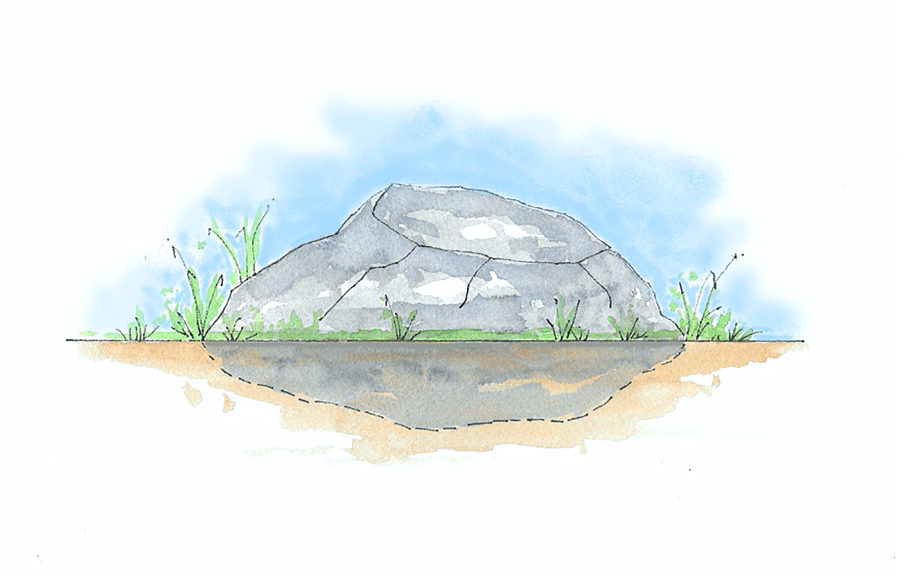A few things to consider when using rocks in your garden.

Rocks last forever* (Please don’t report me to a geologist!)
Rocky top, rock city, rock gardens, rock lobster, rock & roll. Guess what I’ll be writing about today? Yes! So, tie on that bib, melt some butter, and let’s dig in! (Since when have I ever started one of these writings predictably?)
You can have a garden that doesn’t have many (if any) plants at all. I’m talking about a rock garden, and they’re a viable option for homeowners who want an alternative to traditional landscaped beds. With that said, a rock garden can be beautiful, use fewer water resources, and low maintenance (for those that follow me, you know that I’m not a big fan of that term).
Building the perfect rock garden boils down to two considerations: picking the correct type of rock and then choosing an arrangement that looks natural. I’ll refrain from going into a feng shui ramble. But after placing some boulders at my adopt-a-spot garden just down the street, I had a neighbor compliment me on the layout and then ask me which Eastern philosophy sect I was trying to emulate. “I just did what looked good”, was my over simplistic response.
There are various reasons to choose a rock garden over a purely plant-based approach.. I see a rock garden as an option for people with three types of goals: convenience, aesthetics and functionality. Rock gardens, or “rockeries” as they’re known to our UK friends, also make wonderful habitat for blue-tailed skinks and other critters. If you live in a snake-prone area and have a phobia about those guys, you may want to stop reading now.
You may have heard the saying, “He/she is as dull as a box of rocks”. Being a bit of a rock collector (please don’t call the rock cops), I would argue that there are MANY things duller than rocks (a yawning festival, perhaps). I consider them nature’s architecture. Unlike many plants, rocks don’t die. There are many that actually host extremely slow-growing living organisms such as lichen and moss. The colors that can be coaxed out of some nice boulders (Sorry, I was getting tired of writing “rocks”) can be magnificent after they get wet. Also, most rocks/boulders retain heat, which can benefit some plant species in creating a small-scale micro-climate.

Rocks and plants living in harmony. Awwww!
So, is it a rock or a boulder? That one is pretty subjective but I would put the latter in a category of needing some machinery to move. I was just talking to a friend from whom I’m going to get a couple of nice stone steps for my daughter’s garden. “I’ll bring the mini-loader and we’ll get those into place.” Thanks, Adam! Machinery over muscle. My doctor will thank you.
PLACEMENT and INSTALLATION
This deserves its own heading as both are key to using this material successfully in your garden. I actually gave presentations to my students and garden clubs on this subject because it is SO important.
Placement: allow your rocks to be friends. Let them hold hands. Also, use a variety of sizes! Nothing screams novice louder than seeing a garden with stone fragments scattered throughout. If you don’t have a few “manly” rocks in the mix, you have failed the test. (and look like that crazy person who stops their car alongside the road to throw another reject in the trunk.

I remember social distancing (and not at all fondly). Don’t force your rocks to do the same. Let them touch and be buddies!
Installation: This one is easy. PLANT your boulders and rocks! These should be buried up to the point of their widest measurement so they truly do resemble the tip of an iceberg, as nature’s rock outcroppings do. If you can’t dig down for some reason, add some soil all around the circumference to achieve a similar effect.

A properly installed boulder

NOT properly installed. Looks like they just fell off the truck, which they probably did.
ACQUIRING ROCK
Don’t steal rocks! There are ethical, sustainable ways to bring some of these beauties home. Don’t take them from parks or the national forest. There are rock/stone vendors who have permission to go on lands such as strip mines, construction sites, etc. and these are the ones to patronize. If you see a hatchback or truck exiting the Great Smoky Mountain National Park with their two front wheels barely making contact with the ground, DO NOT buy from him! I was once told that technically, you need a mining permit (maybe mining permit “light”) to harvest rocks in our state. I haven’t dug enough to find out if this is true but hopefully, you get my drift on acquiring boulders.
Alright. There you have it. One more rambling episode of “What’s on Garry’s Mind”. Today’s lesson: don’t be afraid to add another dimension to your beautiful garden.
Till next time,
ROCK ON, MY FRIENDS!
Please share and subscribe! https://ahomeforyourgnome.com/

